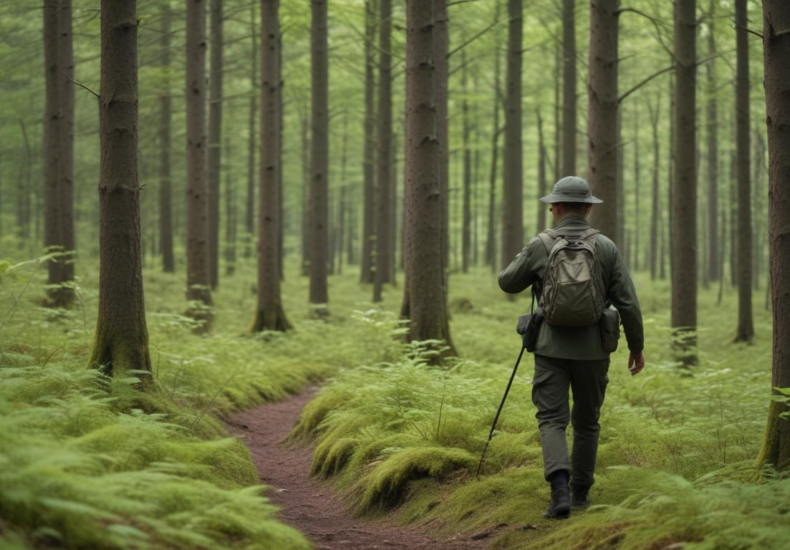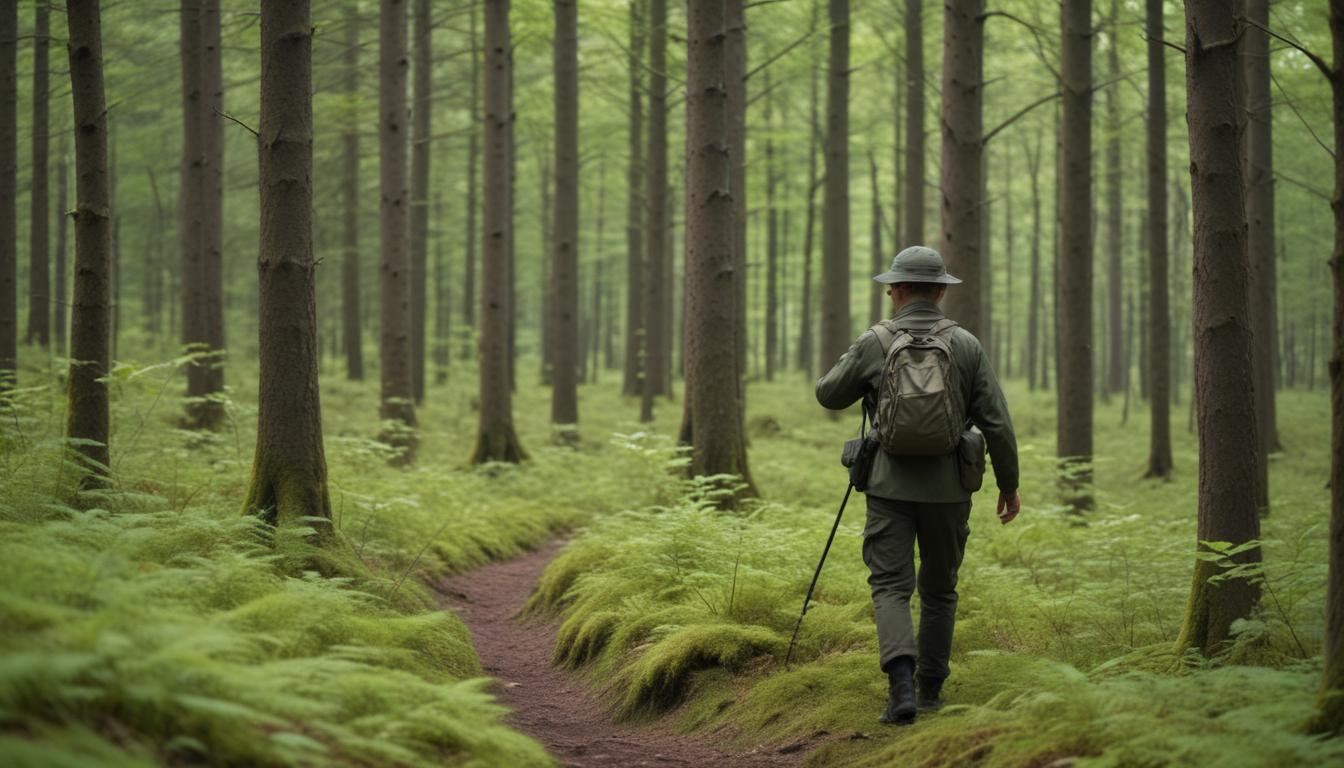
Detecting in forests: what to watch out for
When venturing into the forest for detection tasks, whether it be for research, conservation efforts, or forest hunting, it’s crucial to be aware of potential hazards posed by the local flora and fauna. Poisonous plants, such as poison ivy, poison oak, and poison sumac, are prevalent in many forests and can cause severe allergic reactions upon contact. Identification skills are paramount; these plants typically have shiny, compound leaves and can grow as bushes or climbing vines. It’s advisable to wear protective clothing and keep a barrier between your skin and the vegetation.
Similarly, the fauna in the forest can pose significant risks. Venomous snakes, like rattlesnakes or copperheads, often camouflage themselves among fallen leaves and underbrush, making them hard to spot. Wearing sturdy boots and being vigilant of your surroundings is essential to avoid unexpected encounters. In some regions, you might also encounter large mammals such as bears or mountain lions. These animals are generally averse to human contact but can be dangerous if surprised or provoked. Carrying bear spray and knowing how to store food safely can mitigate the risks of attracting these larger predators.
In addition to larger animals, insects such as ticks and mosquitoes are common and can be not only a nuisance but also carriers of diseases like Lyme disease or West Nile virus. Protective gear, including long sleeves, pants, and insect repellent, is vital to guard against bites. Furthermore, always check your gear and clothing for ticks after moving through grassy or wooded areas.
Understanding these hazards and preparing adequately before heading into the forest can greatly enhance your safety and allow you to focus more effectively on your detection tasks.
Navigating forest terrain
As you delve deeper into forest environments, effectively navigating terrain becomes a crucial aspect of both safety and success in your detection tasks. Forest floors can vary greatly, ranging from dense underbrush to rocky outcrops, which can challenge even the most experienced outdoors enthusiast. To safely move through these areas, it’s important to have the right gear and knowledge.
Firstly, assess the type of terrain you will be encountering. In deciduous forests, for instance, the ground may be covered with a thick layer of leaves that can hide obstacles like roots or holes, posing risks of tripping or twisting an ankle. In contrast, coniferous forests might have softer, needle-covered grounds but denser tree growth, requiring more careful navigation to avoid getting lost. Always use a map and a compass as part of your essential navigation gear, and consider employing a GPS device for real-time location tracking.
When navigating steep inclines or rocky areas, appropriate footwear is essential. Shoes with good grip and ankle support can prevent falls and provide stability. It’s also wise to use trekking poles to balance and distribute weight evenly, making it easier to handle uneven or slippery surfaces that are often encountered in forested terrains. These tools become particularly valuable when carrying heavy equipment for forest hunting or other detection activities.
Additionally, take into account how the presence of water bodies can affect your travel through the forest. Streams and rivers can become impassable barriers during heavy rain, and wet, muddy conditions can turn even flat trails into challenging obstacles. Always plan your route with potential water hazards in mind, and be prepared to find detours or wait for waters to recede.
Visibility can also be limited under the dense canopy of trees, which affects how well you can judge distances or spot other landmarks. When moving through such areas, slow your pace and allow extra time to navigate to ensure accurate and careful progression. During all this, keep your detection gear securely fastened and accessible, as rough terrain could cause damage to unsecured equipment.
Awareness of your surroundings in terms of the terrain’s natural features not only enhances safety but can also enrich the experience of your forest expedition, making your detection tasks more effective and enjoyable. Always remember that the unpredictable nature of forest terrains requires flexibility and patience, along with the necessary preparedness to address any challenges that come your way.
Weather and seasonal considerations
Understanding the impact of weather and seasonal changes is imperative for anyone planning forest activities, especially for tasks that require precision and safety like forest hunting, biological research, or geographic mapping. The season you choose to enter the forest can drastically alter the conditions you’ll face, influencing not only your comfort but also the success of your endeavors.
In the spring, while the melting snow and rising temperatures can make the forest come alive with budding trees and blooming flowers, these conditions can also lead to muddy and slippery terrain. Additionally, this period often sees increased water levels in rivers and streams, which could require waterproof gear and careful consideration of water crossing strategies. Moreover, spring is typically a high period for ticks, necessitating protective clothing and frequent checks.
Summer brings its own set of challenges, predominantly heat and humidity that can lead to dehydration and heat exhaustion if proper precautions aren’t taken. Dense foliage during summer can restrict airflow, making areas under the canopy particularly stifling. This season often suggests a lightweight but durable gear setup, ample water supplies, and possibly a change in schedule to utilize the cooler parts of the day for intensive activities.
Fall, while offering cooler temperatures and reduced insect activity, presents shorter days, requiring efficient time management to maximize daylight hours. The beauty of changing leaves is undeniable, yet the falling foliage can obscure paths and hide obstacles underfoot, increasing the risk of slips or trips. Also, fall is a popular season for various hunting activities, so wearing high-visibility clothing becomes important to ensure safety among more frequent forest visitors.
Winter, though stark and sometimes starkly beautiful with snow-covered landscapes, demands the greatest preparation. Snow and ice can make navigating through forests treacherous. Layered clothing, thermal gear to prevent hypothermia, and equipment for snow and ice like crampons or snowshoes are essential. Also, with shorter days and potentially severe weather conditions, planning for emergency situations with extra supplies and a well-thought-out exit strategy is crucial.
Regardless of the season, always monitor weather forecasts and be prepared to adjust your plans accordingly. Sudden weather shifts can drastically affect visibility, the stability of paths, and your overall safety. Efficient planning according to the seasons and being equipped with season-appropriate gear ensures not only personal safety but also a more fruitful and enjoyable experience in the forest environment.
Essential tools for detection tasks

Having the right tools for detection tasks in forest environments is crucial for both the effectiveness and safety of your endeavors. Whether you’re engaged in forest hunting, biological research, or simply exploring, certain gear is indispensable for navigating the terrain and achieving your objectives. First and foremost, a dependable and accurate handheld GPS device can prove invaluable in keeping you oriented and on track. In areas where GPS signals might be unreliable due to dense tree coverage, having a traditional compass and detailed topographic maps of the area continues to be an essential backup.
For tasks that involve observation, recording, or sampling, specialized equipment such as binoculars, cameras with high zoom capacities, and portable environmental meters (to measure humidity, temperature, or light) become necessary. When moving through areas with dense underbrush or thickets, machetes or similar cutting tools can help in clearing a path or collecting samples without causing extensive disruption to the surrounding flora.
If your detection work in the forest includes night-time activities, a high-quality headlamp or a handheld torch with extra batteries is mandatory. These tools not only aid in navigation but are also crucial for safety, helping to deter wildlife and prevent accidents in low-light conditions. Additionally, portable, lightweight seating or climbing equipment can be beneficial when waiting for wildlife or conducting extended observations in specific locations.
For those involved in forest hunting, specific gear such as scent eliminators, game calls, and camouflage clothing can significantly increase the chances of a successful hunt by blending seamlessly with the environment and minimizing human scent. Moreover, the choice of footwear and clothing should not only consider camouflage but also durability and protection against the elements and natural hazards of the forest, such as thorns or wet conditions.
Lastly, it’s essential to pack a robust first-aid kit tailored to the specific risks associated with forest environments, including supplies for treating cuts, sprains, insect bites, or exposure to poisonous plants. Being well-prepared with the right tools not only enriches your experience in the forest but also safeguards your well-being, allowing you to focus on the tasks at hand with greater confidence and efficiency.
Safety practices and emergency preparedness
Ensuring your safety in the forest, particularly during tasks like forest hunting or traversing challenging terrain, requires more than just carrying the right gear. It necessitates comprehensive safety practices and emergency preparedness measures to tackle unforeseen situations effectively. Being equipped with knowledge and tools to handle emergencies can literally be a lifesaver in the unpredictable forest environment.
Before embarking on any forest-related activities, it is vital to inform someone of your expected return time and the specific location you plan to explore. This basic step can ensure that help is dispatched in a timely manner should you fail to return as scheduled. Moreover, carrying a fully charged cell phone and a portable power bank, while not always reliable in remote areas due to signal issues, can be crucial for calling for help when possible. For areas with known poor reception, considering renting or purchasing a satellite phone or a personal locator beacon (PLB) can be a wise decision. These devices allow for emergency communication directly with search and rescue services, bypassing typical cellular networks.
In addition to communication devices, equipping yourself with a comprehensive first aid kit is another essential practice. Your kit should include items tailored to possible forest hazards, such as bandages, antiseptics, pain relievers, medications for allergic reactions, and tools for splinting in case of sprains or fractures. Understanding basic first aid and CPR techniques through certified courses can also augment your ability to manage health emergencies until professional help is available.
Aside from health-related emergencies, getting lost remains a significant risk in dense forest areas. Employing the use of GPS devices and always carrying a physical map and compass can prevent disorientation. Ensure you are familiar with navigation basics and practice using these tools in a safe environment before your trip. For those involved in forest hunting, carrying fluorescent markers to track your path or mark locations for easy visibility can also be a helpful strategy for staying oriented.
Finally, the unpredictability of encountering wildlife necessitates specific safety measures. Besides the bear spray mentioned earlier, understanding the behavior of various forest animals and knowing how to respond during encounters can reduce the risks of aggression. For example, making noise while moving through bear territories can prevent surprise encounters, and knowing how to make yourself appear larger and back away slowly can be useful during unexpected meetings with mountain lions.
Safety in the forest is not just about personal preparation but also about respect and understanding of the environment and its inhabitants. By combining the right gear, knowledge, and practical safety measures, you can significantly enhance your security and enjoyment of the natural world.
You may also like
Archives
Calendar
| M | T | W | T | F | S | S |
|---|---|---|---|---|---|---|
| 1 | 2 | |||||
| 3 | 4 | 5 | 6 | 7 | 8 | 9 |
| 10 | 11 | 12 | 13 | 14 | 15 | 16 |
| 17 | 18 | 19 | 20 | 21 | 22 | 23 |
| 24 | 25 | 26 | 27 | 28 | 29 | 30 |
Leave a Reply